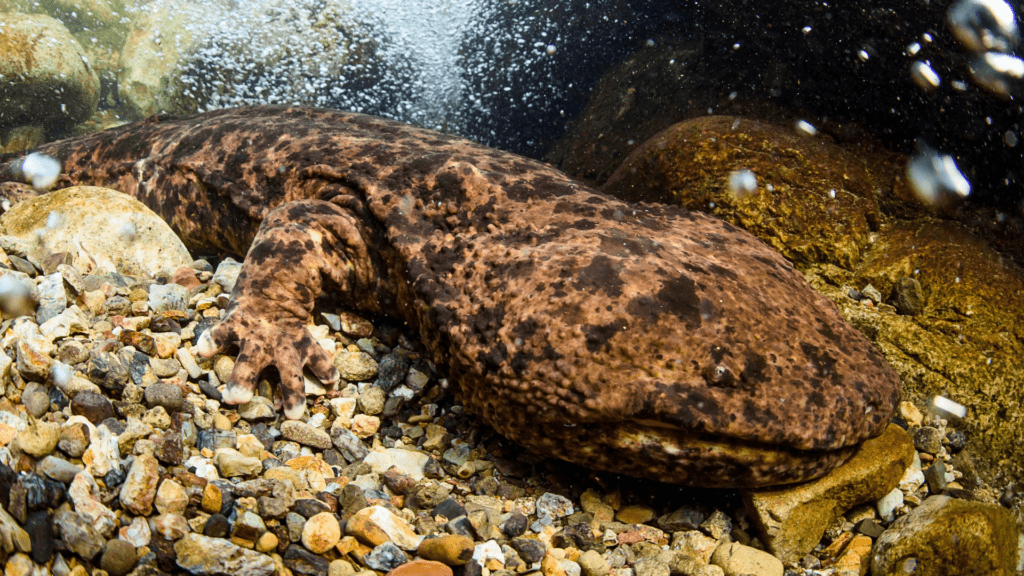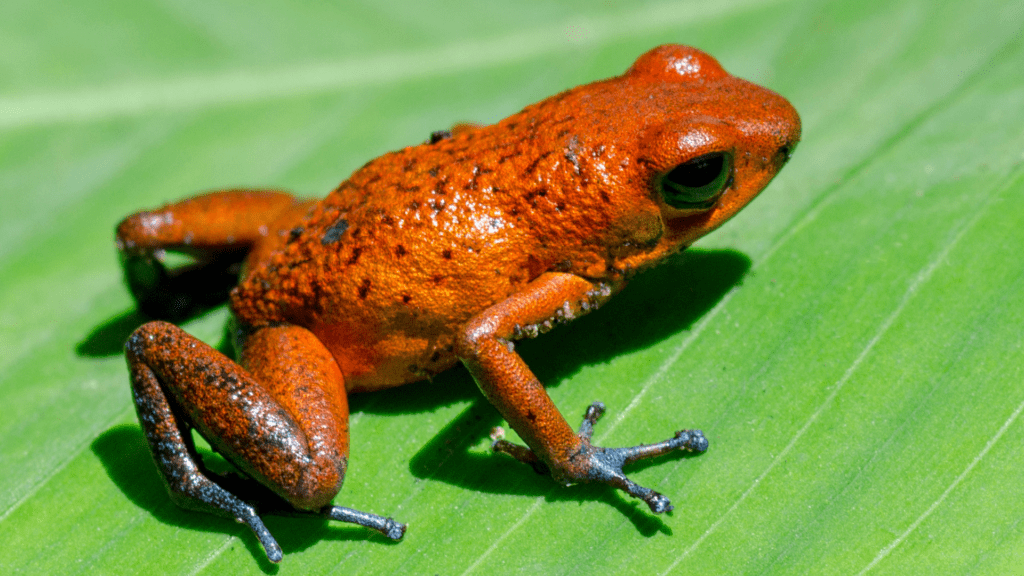Pool Frog (Pelophylax lessonae) is a species of water frog native to Europe. Recognized as a distinct species in 1973, these amphibians are often confused with other common frog species due to their similar appearance. They are primarily found in small, sunlit water bodies surrounded by woodlands and meadows. Their ability to thrive in various aquatic environments and their unique behaviors, such as basking in the sun, set them apart from many other frog species.
Scientific Classification
Kingdom: Animalia
Phylum: Chordata
Class: Amphibia
Order: Anura
Family: Ranidae
Genus: Pelophylax
Scientific Name: Pelophylax lessonae
Description
Size: Pool Frogs typically grow between 2.5 and 3 inches in length. Females are larger than males. The tadpoles measure 5 mm to 9 mm at birth and grow to 50 mm to 75 mm before metamorphosis.
Color: Their body color ranges from olive green to brown with dark brown spots on the dorsal side. A distinct yellow stripe runs down the center of their back. The ventral side is off-white or cream. Their eyes are surrounded by a golden hue.
Head: They have a pointed snout and lack dark patches around their eardrums, distinguishing them from other frogs.
Eyes: They have horizontal pupils.
Distribution
Pool Frogs are native to Europe, with populations in Austria, France, Germany, Italy, the Netherlands, and Belgium. Their range also extends to the United Kingdom and Scandinavian countries such as Denmark and Sweden.
Habitat
These amphibians inhabit small, sunny, and permanent water bodies surrounded by woodlands. They are commonly found in ponds and lakes in meadows, preferring areas where sunlight warms the water. They frequently bask on floating leaves and vegetation. In their native regions, they were historically found in pingos—ponds formed by depressions during the last Ice Age.
Diet
Adult Pool Frogs are carnivorous, feeding on insects and invertebrates such as wasps, hoverflies, and dragonflies. They occasionally consume smaller amphibians. Tadpoles primarily eat algae, while juveniles feed on large numbers of flies and fly larvae.
Behavior
- Pool Frogs are diurnal and remain active during the daytime.
- They are most active in hot weather and often bask in direct sunlight, which is uncommon for frogs.
- When threatened, they dive into water for safety.
- They emit a loud defensive call when trapped.
- They can travel long distances from water in search of food.
- The presence of humans does not significantly disturb them.
Predators
Common predators of Pool Frogs include grass snakes, owls, hornbills, and various aquatic birds like herons.
Adaptations
- They can detect even the slightest movements of predators, helping them evade danger.
- Their ability to flatten their bodies enhances camouflage, making them harder to spot.
- Their strong swimming skills aid in both hunting and escaping predators.
Mating Season
The breeding season begins in May and lasts until late June, though in some regions it starts as early as March.
Reproduction
Pool Frogs reach sexual maturity at two to three years of age. Mating occurs immediately after hibernation. Males produce loud calls to attract females. They breed in still waters such as ponds, swamps, and lakes. Females lay 500 to 4,500 eggs per clutch, which are externally fertilized. The incubation period lasts around 21 days, depending on climate conditions.
Life Cycle
Tadpoles undergo metamorphosis between August and September, transforming into froglets.
Life Span
The lifespan of Pool Frogs ranges from 6 to 12 years.
Genetic Factors:
:Some individuals may have genetic traits that allow them to survive longer, especially in stable environments with minimal disturbances.
Environmental Impact on Longevity:
Factors such as water temperature, food availability, and predator presence can influence their lifespan. In temperate regions with sufficient resources, some individuals may live longer.
Captivity vs. Wild:
In the wild, they face threats like habitat destruction, pollution, and predation, which can shorten their lifespan. In captivity, under optimal conditions, they may live slightly longer due to the absence of natural threats.
Seasonal Influence:
Their hibernation period helps conserve energy and may contribute to their longevity by reducing metabolic stress during colder months.
Pool Frog Call
Their mating call resembles a rapid snoring sound, with each croak lasting up to 1.5 seconds. They call during both day and night in the breeding season. When threatened, they produce a loud croaking sound.
Hibernation
Pool Frogs hibernate from fall through spring, typically from September to November. In colder regions, hibernation extends from March to May. They hibernate on land, inside tree cavities, and in frost-free burrows.
Interesting Facts
- The genus name “Pelophylax” derives from Greek words meaning “mud” and “guardian,” referencing their habit of sitting still near water edges.
- Their tadpoles grow larger than those of most frog species.
- Adult and juvenile Pool Frogs sometimes prey on juvenile grass snakes, despite adult snakes being one of their main predators.
- They were once extinct in the UK but have since been reintroduced.
- Keeping them as pets is illegal.
Conservation Status
According to the IUCN, Pool Frogs are classified as Least Concern, meaning they are not currently at significant risk of extinction.
faq:s
1. What is the scientific name of the Pool Frog?
The scientific name is Pelophylax lessonae.
2. Where are Pool Frogs found?
They are native to Europe, particularly in the UK, France, Germany, and parts of Eastern Europe. They thrive in freshwater habitats like ponds, lakes, and marshes.
3. What do Pool Frogs eat?
They are carnivorous and feed on insects, spiders, worms, and other small invertebrates.
4. How do Pool Frogs reproduce?
Breeding occurs in spring and early summer. Males attract females with croaking calls, and females lay clumps of eggs (frogspawn) in water.
5. What is the lifespan of a Pool Frog?
Pool Frogs typically live for 5-10 years in the wild.
6. How do Pool Frogs survive winter?
They hibernate during winter, often in mud at the bottom of ponds or under logs and rocks.
7. What are the predators of Pool Frogs?
Predators include birds, snakes, fish, and larger amphibians. Tadpoles are vulnerable to aquatic predators like dragonfly larvae.
8. How can you identify a Pool Frog?
They have smooth, green or brown skin with dark spots, a light stripe down their back, and a pale underside.
9. Are Pool Frogs endangered?
In some regions, they are considered endangered or vulnerable due to habitat loss, pollution, and competition with invasive species.
10. What is unique about Pool Frogs?
They are one of the three species that make up the “green frog” complex, which includes hybrid species like the Edible Frog (Pelophylax esculentus).


My wife and i ended up being absolutely excited that John managed to round up his analysis through the entire ideas he gained through the weblog. It is now and again perplexing just to choose to be releasing information and facts which others have been selling. And we recognize we now have the blog owner to be grateful to for that. Most of the illustrations you’ve made, the simple blog menu, the relationships you can aid to create – it’s many wonderful, and it is leading our son in addition to our family consider that the idea is awesome, which is certainly especially fundamental. Many thanks for everything!
Hi there! Thank you so much for your kind words. I’m truly glad to hear that the blog has been helpful and meaningful to you and your family. Your appreciation means a lot and motivates me to keep sharing valuable information. Wishing you and your family all the best! 😊